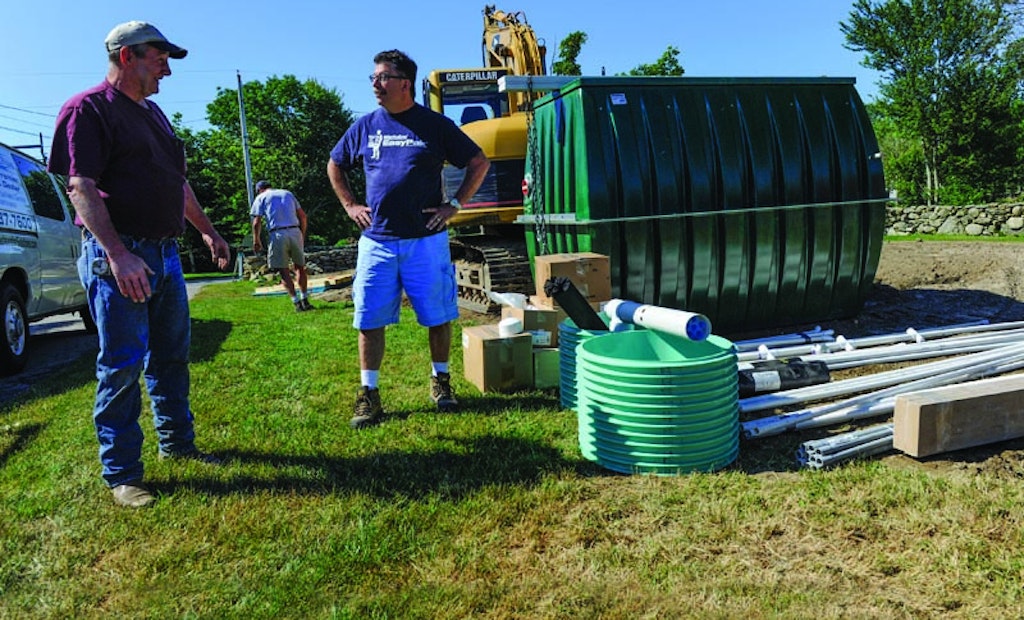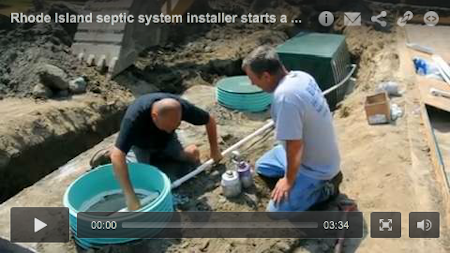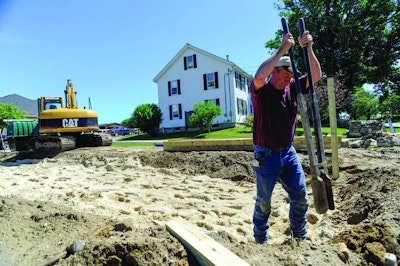
Interested in Systems/ATUs?
Get Systems/ATUs articles, news and videos right in your inbox! Sign up now.
Systems/ATUs + Get AlertsBrendan Cory has had a lot of jobs and worn a lot of hats during a four-decade career in the onsite industry. Right out of high school, his uncle put him to work on an excavator. Although he was working for a general contracting business, Cory quickly felt a calling to and comfort with onsite system assignments.
Then, after 23 years with the company and as one of about 30 employees, he was thrust into a supervisory role when his uncle died. His last assignment was to supervise completion of all active jobs and close the company. After completing that assignment, he signed on with an onsite-focused installer as a crewmember; then in 2010 he was again without work.
“I was laid off and could have stayed on unemployment but I saw too many opportunities. I could not sit around, so I started my own business,” recalls Cory, now 59. He works under the business name BSC Environmental in Little Compton, R.I.
Located about 60 miles southwest of Boston, Cory works across all of his tiny home state and throughout southeastern Massachusetts. He will travel the entire stretch of Cape Cod.
ALONE TOGETHER
Like many sole proprietorships, Cory has no employees. Unlike most installers, he has no storage yard filled with earth-moving equipment. Instead, he has a collaborative relationship with another sole proprietor; they refer work to one another and work most installation and repair jobs in tandem.
Kevin Wilkie works alone as owner of KMW Enterprises, which has an array of excavation machinery. “We are both cross-trained and appropriately licensed operators, but I do the installations and Kevin does the earthwork,” Cory explains. The collaboration is efficient and rewarding.
Focusing on installation-specific tasks, Cory says “large volumes of aggregate material, necessary tankage and most supplies are purchased and delivered to the job site. This lets both of us stay focused on the tasks we do best.”
About half of Cory’s work is installing replacement systems for existing homes, so he talks to a lot of homeowners. Often the discussions come too late to help system owners prevent catastrophic failure, but just in time to let him explain how an onsite system works, its maintenance needs and the customers’ obligation to protect its performance.
PARTIAL TO THE ATU
“I push ATU systems. They are less expensive to install and operate. With near-surface seasonal high water tables, there is often no alternative,” he concludes.
Cory’s comfort with ATUs is acquired through hands-on experience. “I like to climb on, poke around and get to know the ins and outs of a system before I recommend that system,” he explains. He has personally evaluated many industry products, including those from Orenco Systems, SeptiTech, Bio-Microbics, Singulair (Norweco) and Cromaglass. When selecting a technology, he says, “The site’s conditions drive my recommendation. The technology and site must be a good fit.”
Another reason he holds out for his ATU preference, especially for replacements, is that – soil conditions aside – the ATU is often an easier fit into a constrained site. “There is not always a lot of space to fit in tanks and an absorption area, but with an ATU, the absorption area is often smaller and that helps both the landowner and me.”
Rhode Island regulations allow installers to design certain repair systems and undertake system repairs. His repair solutions often include time-dosing of treatment tank effluent to the ATU and/or the absorption area. A common mistake he frequently encounters involves the grade on the pressurized effluent delivery line. “Laterals in the absorption area must be installed absolutely level, but the delivery line to the header must have a minimum 2 percent slope away from the header toward the pump tank.” Cory and Wilkie share a common view on elevation and grade accuracy. They observe a zero tolerance standard; things must be dead-on and as designed.
SYSTEM MANAGEMENT
Maintenance services are about 20 percent of Cory’s work. For the roughly 60 systems he has in the ground and under contract, he follows a precise, tailored service protocol to augment manufacturer’s specifications. Both Rhode Island and Massachusetts require ATU maintenance agreements, although enforcement is not consistent across state lines.
Cory offers a two-year contract with twice-a-year system checks. The first step is a motor amperage test to look for signs of problems or potential failure. He also performs a lateral end pressure check. Lower than expected pressure leads to further investigation. Filters – passive, reduced aperture technology or intentionally designed to be biologically active – are inspected on each visit and serviced as needed.
“I tell landowners, ‘When you must call for a pumpout to resolve a problem, it is usually too late to save the system,’ ” he says. Cory has found pumpers may fail to clean filters, or worse. “Pumpers yank them out and discard them,’’ he says. “Homebuilders, too, want to avoid service calls, so after the system is installed and inspected, many do the same thing.”
When advanced treatment technologies are selected, maintenance is a necessity. Cory knows better-educated installers and service providers are better at educating homeowners. And consumer education is a task he willingly takes on.
BOOSTING PROFESSIONALISM
“Professional development, mandatory basic and continuing education requirements, and consistently applied and enforced regulations will benefit my industry. They will bring respectability into this occupation,” Cory says. Giving high marks to the leadership of George Loomis and David Kalan, both of the New England Onsite Wastewater Training Program, Cory feels installers enjoy a helpful relationship with the University of Rhode Island Extension Service.
The Extension Service’s two-day training helped Cory attain certification as a registered onsite wastewater system inspector. Inspections by credentialed individuals are required by many towns for system owners to comply with maintenance or management ordinances. This credential is also a prerequisite for time-of-sale real estate inspections, which account for about 10 percent of Cory’s workload.
The New England Onsite Wastewater Training Program addresses all facets of onsite system training, but Cory would like to see a dedicated trade group in his home state.
“I would love to see an onsite association in Rhode Island,’’ Cory says. “It would be a place for peer-to-peer mentoring, a voice for the industry in addressing any needed regulatory changes and a forum to swap techniques and practices.”
BSF DECONSTRUCTED
Less than the legendary “Wisconsin mound” or an “elevated sand mound,” the Rhode Island bottomless sand filter was created to address a variety of issues. The BSF, as it is known, has emerged to solve challenges presented by near-surface water tables, zero-grade sites and the need to eliminate failing systems through repairs or enable new development. It is also a solution for tiny, constrained sites.
Like the Wisconsin mound, the BSF is built with a clean, graded fine aggregate placed in direct ground contact. Also like the mound, the BSF relies on a site-built retaining system to constrain the fine aggregate and a pressurized effluent delivery system. But this is where the family resemblance quickly fades.
Construction begins when the installer lays out a 12- by 18-foot rectangle on the site. The surface vegetation within is removed and then things get rolling. Cory describes the system:
“On that footprint, I assemble a 24-inch-high retaining perimeter using 4- by 4-inch pressure-treated, ground-contact-rated landscape timbers.” To ensure the grade of the finished retaining system remains level, Wilkie uses a hydraulic auger on one of his machines to bore holes at each corner and at 6-foot intervals along each side. Into each hole a 4- by 4- by 36-inch square-cut timber is installed vertically. On top of these posts, the first horizontal “course” of 6- by 6-inch timber is placed. Each succeeding course has staggered joints and is secured to the one below.
“I developed the post idea to ensure that the finished timber frame stays level as intended,” Cory explains. “I use ‘Timberloc’ screws for these connections because they have a more aggressive bite.” To ensure close-tolerance butt joints, the team uses a beam saw rather than a chain saw.
DIRECTING THE EFFLUENT
To ensure effluent moves down through the sand material, the entire interior surface of the timber perimeter is covered with a heavy 30-mil PVC liner, which prevents through-the-side breakouts.
Once the first 3 or 4 inches of sand have been placed, the teeth of an excavator bucket are used to thoroughly mix the previously scarified upper soil layer with the placed sand. When the transition zone is thoroughly mixed, the balance of the sand, 24 inches total, is placed. A 3-inch layer of 5/8-inch stone is placed on the sand and then raked to a level surface.
The pressure effluent line is connected to a manifold, which services the six laterals. Laterals resting on the stone have discharge holes 18 inches on center. The holes point downward and are fitted with oriface shields. The pipe network is covered with 7 to 8 inches of 5/8-inch stone.
While this design is typical for a BSF, the sand/soil interface varies from on-grade to several inches below grade. “One job I worked on had soil conditions that allowed most of the sand to be placed in an excavation. The finished product has only a single 6-inch by 6-inch timber exposed,” says Cory.
When finished, the top is raked level and left exposed and free of all vegetation. Cory has installed several of these BSFs, which all receive effluent from an ATU.
ONWARD AND UPWARD
Cory has built a career on basic and continuing education and practical experience. Knowing what technologies will address specific challenges, how they work and how to maintain them have prepared him for effective customer education and to be an advocate for higher industry standards.
MORE INFORMATION
Bio-Microbics, Inc. - 800/753-3278 - www.biomicrobics.com
Norweco, Inc. - 800/667-9326 - www.norweco.com
Orenco Systems, Inc. - 800/348-9843 - www.orenco.com
SeptiTech, a subsidiary of Bio-Microbics, Inc. - 800/318-7967 - www.septitech.com











